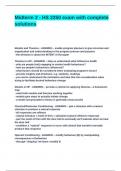Midterm 2 - HS 2250 exam with complete
solutions
Models and Theories - ANSWER- - enable program planners to give structure and
organization and understanding to the program process and purpose
- the direction is about the INTENT of the paper
Theories in HP - ANSWER- - help us understand what influences health
- why are people (not) engaging in certain health behaviours?
- how are people's behaviours influenced?
- what factors should be considered when evaluating program's focus?
- provide insights and directions, e.g. students, readings
- you ned to understand the motivation and take that into consideration when
trying to facilitate desired behaviour change
Models in HP - ANSWER- - provide a vehicle for applying theories - a framework,
map
- need both models and theories working together
- models give steps to actually initiate change
- a model not grounded in theory is generally unsuccessful
Classical/Pavlovian Conditioning - ANSWER- - pair a stimulus with a natural
stimulus to produce a natural response
- all responses are reflexes
- natural stimulus = smell of fries = salivation (natural reflexive response)
- pair the smell of fries with the door bell & eventually we'll salivate when we hear
the door bell
- condition a "natural" response to occur with stimuli that wouldn't normally
produce that response
Operant Conditioning - ANSWER- - modify behaviour (B) by manipulating
consequences of behaviour
- through "shaping" we learn t modify B
,- consequences shape the continuation/termination of B (+ consequence =
continuation of B)
- Skinner is the scientist most often associated with operant conditioning -
Skinner box
Combo Theories - ANSWER- - Stimulus Response (SR) Theory
- Social Cognitive Theory/ Social Learning Theory
- Theory of Reasoned Action (TRA)
- Theory of Planned Behaviour (TPB)
Combo Models - ANSWER- - based on a variety of theories and combos of the
combos
- 2 well known and often used = Health Belief Model and Transtheoretical Model
(Stages of Change)
Precede-Proceed - ANSWER- - 8 step framework for HP programming
- pre-pro works in tandem providing continuous series of steps in planning,
implementation, evaluation of HP programs
- working through it is like solving a mystery
- led to think first inductively then deductively - start with desired ends and work
back to original causes
- e.g. heart disease
P-P Phase 1 - Social Assessment (& Situational Analysis) - ANSWER- - begin with
consideration of Q.O.L
- involve people who will be targeted
- assess some general hopes or problems of concern to a target population
(patients, students, employees, residents, consumers)
- involve people in a self-study of their own needs and aspirations
- acquire subjectively defined problems and priorities of individuals or
communities
- social problems of community offer practical and often accurate barometer of
life
- indicators include: absenteeism, aesthetics, crime, unemployment, self-esteem,
etc.
P-P Phase 2 - Epidemiological Assessment - ANSWER- - essential for program
planning
- task is to match information in phase 1 and 2 (e.g. sick building syndrome)
- and match information to any factors that might be contributing to the main
concerns/problems
, - rank the factors according to things like importance, 'reality', etc.
- consider vital indicators of health including morbidity, discomfort, fertility,
fitness, mortality, physiological risk factors and their "dimensions"
- dimensions of VI indicate the strength of the problem/need-dimensions to
consider include incidence, prevalence, longevity, intensity, functional level,
duration
- incidence - rate of development of a disease measured by number of new cases
in a group of certain time period
- prevalence - # of existing cases of a disease of health condition in a population
as some designated time
- the prioritization needed in this phase can be accomplished by first ranking the
factors by importance and changeability and then using the matrix for narrowing
focus further
Environmental factors - ANSWER- - those determinants outside of the person that
can be modified to support behaviour, health, or Q.O.L
- helps planners be more realistic about the limitations of programs
- also enables them to recognize that powerful social forces might be influenced
when the principles of PROCEED are translated into organizational strategies
applied by groups on the community
Environmental indicators - ANSWER- - economic indicators, physical, services,
social
- dimensions - access, affordability, equity
Behavioural indicators - ANSWER- - compliance, consumption patterns, coping
preventative actions, self-care, utilization
- dimensions- frequency, persistence, promptness, quality, range
Genetic indicators - ANSWER- - genetic predisposition for some, risk factor
Prioritization Matrix - ANSWER- More important less important
more changeable high priority low priotity
less changeable. priority for. no program
innovative program;
evaluation crucial
P-P Phase 3 - Educational & Ecological Assessment - ANSWER- - literally
hundreds of factors could be identified that have the potential to influence a
given health behaviour




